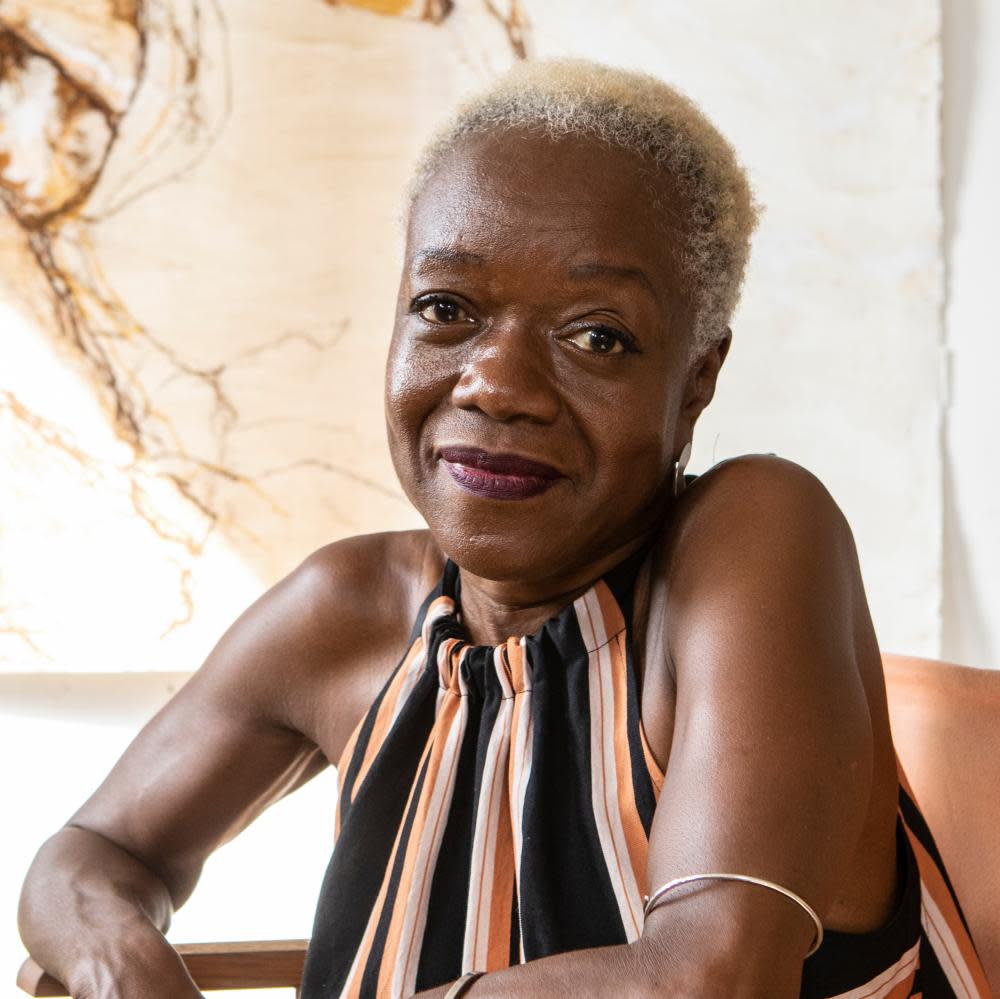Claudette Johnson: Presence review – subtle swipes at the exploitative modern masters
In Claudette Johnson’s large drawings of Black women and men, faces and bodies hold you, frozen in poses that seem more significant than words can say, as if each spontaneous expression or gesture were at the same time a studied symbolic act. Reclining Figure, which is around two and a half metres long, depicts a woman lying down, her face supported by her arms, brooding melancholically or perhaps just daydreaming. Her entire body is swathed in white, against patches of blue and red. The drawing insists on the privacy of her selfhood, and defies you to exploit or possess her with your eyes.
You literally cannot. She slips away from the gaze. In case you miss what Johnson is kicking against in this haunting work, Paul Gauguin’s 1897 painting Nevermore, a treasure of the Courtauld collection, hangs just outside her exhibition. Painted in Tahiti, it gives the eye everything that Johnson’s Reclining Figure refuses. Gauguin depicts a young Tahitian woman lying nude, lost in her own thoughts just like Johnson’s subject – but as she ponders, Gauguin relishes her hips and breasts.
The small first room of Johnson’s exhibition shows how, four decades ago, she set out to question the legacy of modernist masterpieces like Nevermore and their depictions of non-white women. Her 1982 drawing, And I Have My Own Business in This Skin, superimposes a portrait of a modern Black woman over a pastiche of an early 20th century “primitivist” nude. She is literally bursting out of the sexualised, stereotypical prison of modernist images of Africa. In the 1980s this deconstructive energy made Johnson a pioneer of Black British art, exhibiting and campaigning alongside Lubaina Himid, Ingrid Pollard, Veronica Ryan and others who only today are finally getting establishment recognition.
A quest for truth links her big new portrait-like works with those early protests. In her 2019 painting Figure with Figurine, Johnson herself poses in sweater and jeans next to a naked statue of an eroticised African woman, her sombre face daring you to dwell on its nudity. In Standing Figure with African Masks, she similarly poses, confrontationally, next to the kinds of masks and carvings that were collected by and influenced Picasso.
But the quiet power of Johnson’s current work leaves theory behind. Her generously scaled yet coolly constructed drawings focus you firmly on the people they depict. They’re strongly individual, yet not named: even in her self-portraits she calls herself just a “figure”. This is, I think, a strategy to take the heat and rage out of her emotional portrayals. Shock and viscerality are all very well, but Johnson invites a more meditative response.
A big pastel and gouache drawing of a young man in white hat and vest on a hard wooden bed, resting his head on his hand, floating in a sea of blueness is called Kind of Blue. It’s not about Miles Davis – is it? But Miles Davis may be the key, for in Kind of Blue he took some of the rush and heat out of jazz and made it “cool”, pensive, poised. We could be looking at a prisoner in a cell, or maybe the rough bed, sea blue, and the reference to jazz with its deep historical roots contain echoes of slavery. At any rate this is a melancholy study. The man stares into space, pondering pain and loss. Johnson doesn’t name him, but instead gives him a universality. He’s kind of blue, contemplating centuries of suffering.

Johnson’s relationship with artistic tradition is subtly ambivalent. The metal frame next to the bed in Kind of Blue resembles the modernist furniture you see in Francis Bacon’s paintings. And even while she kicks against the racism and sexism of the modern masters, her technique recalls the pastels of Degas and her classical poses invoke Seurat and Ingres. Some of the Courtauld’s Seurat oil sketches also hang just outside her show.
In an untitled drawing a woman stands looking not quite at you, but not past you either, her expression impossible to read, wearing a black dress that covers her broad body, which can only be partly encompassed by the sheet of paper. She is depicted yet not possessed by the drawing: it is as much about what we can’t see as what we can. This is hers, this flesh that’s there but not there, those thoughts you feel but don’t know. She has her own business in this skin.


